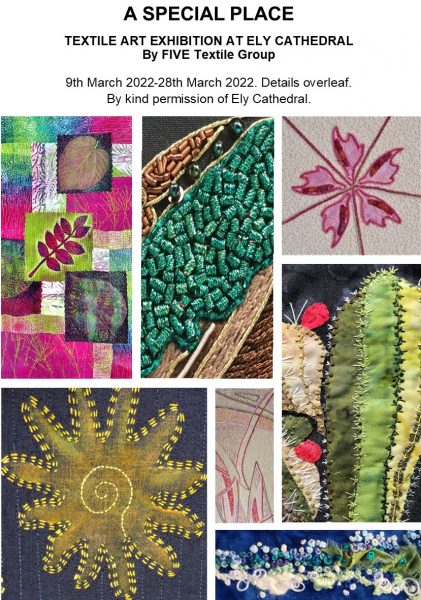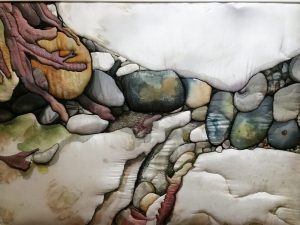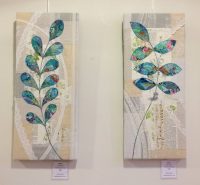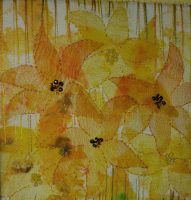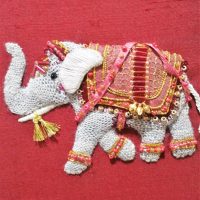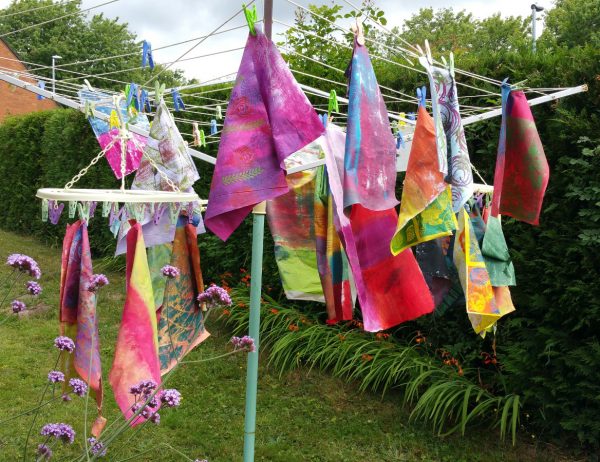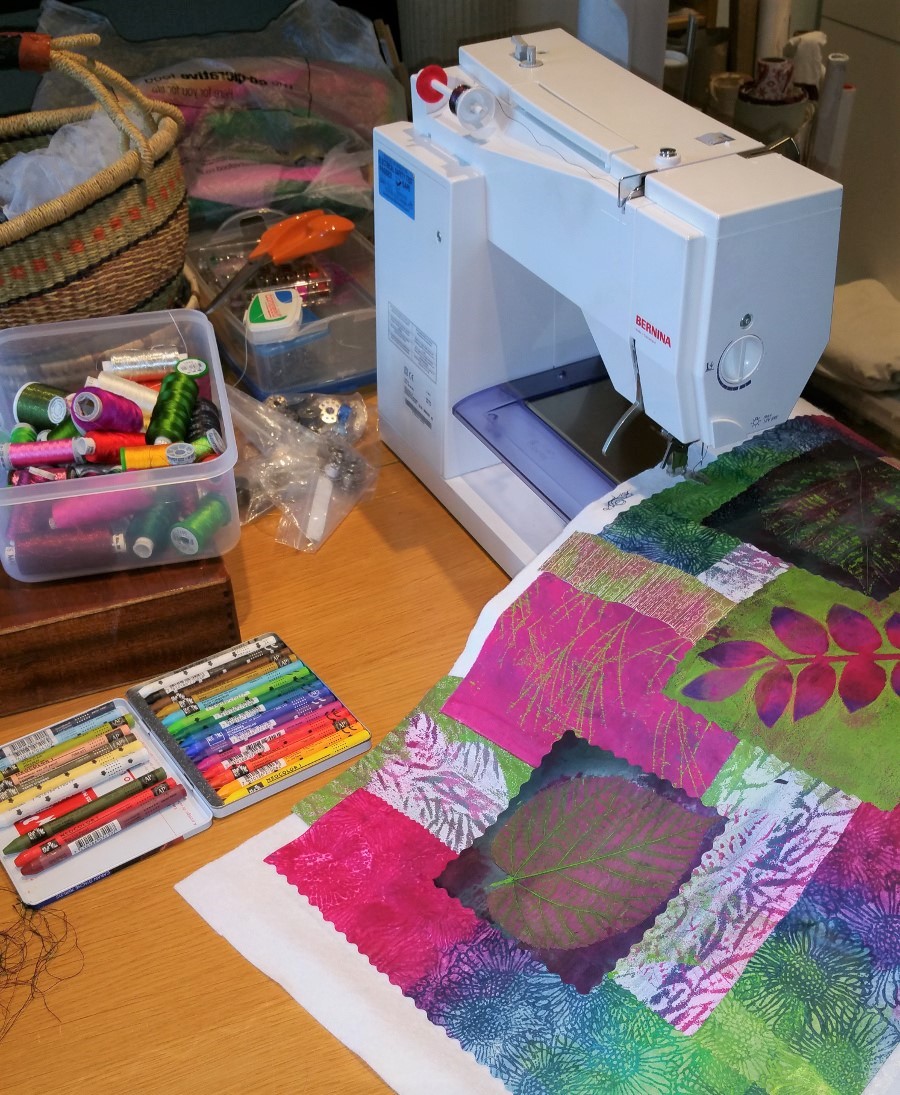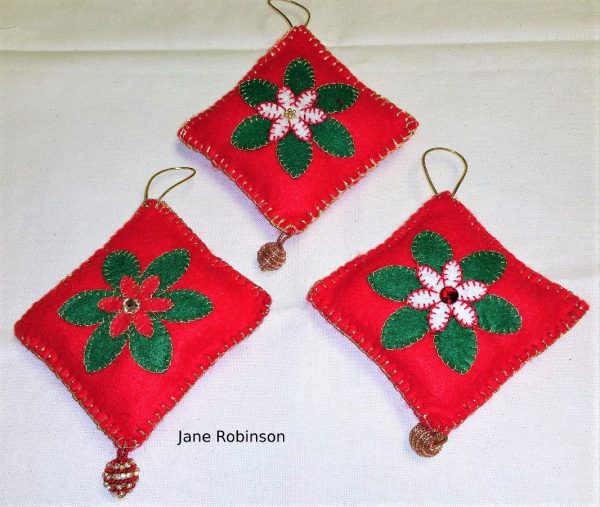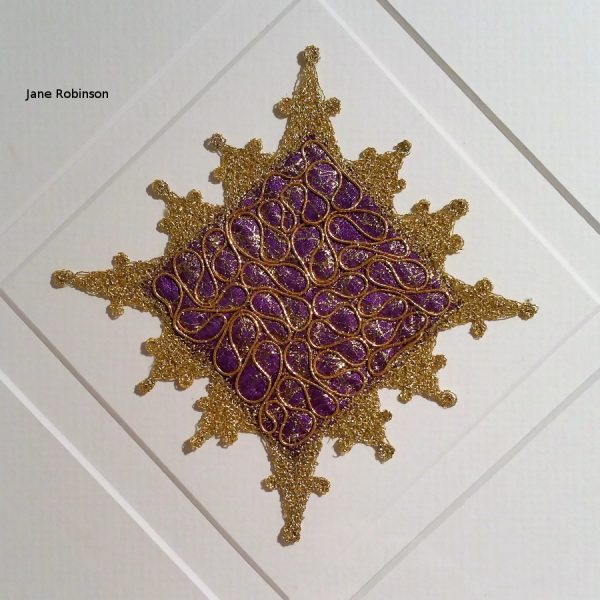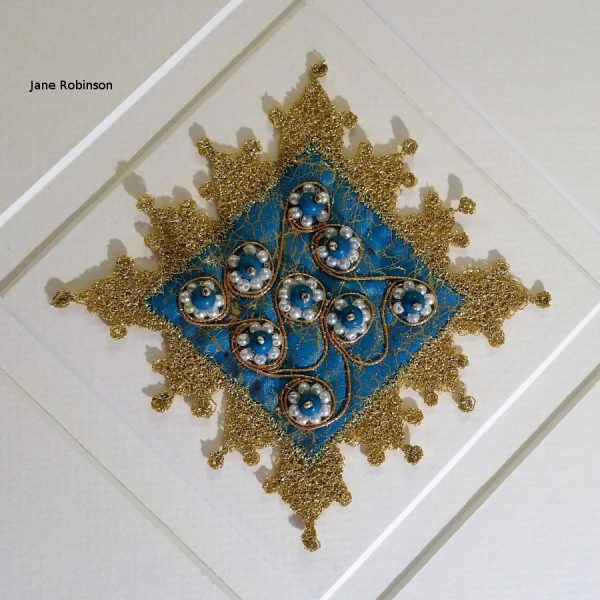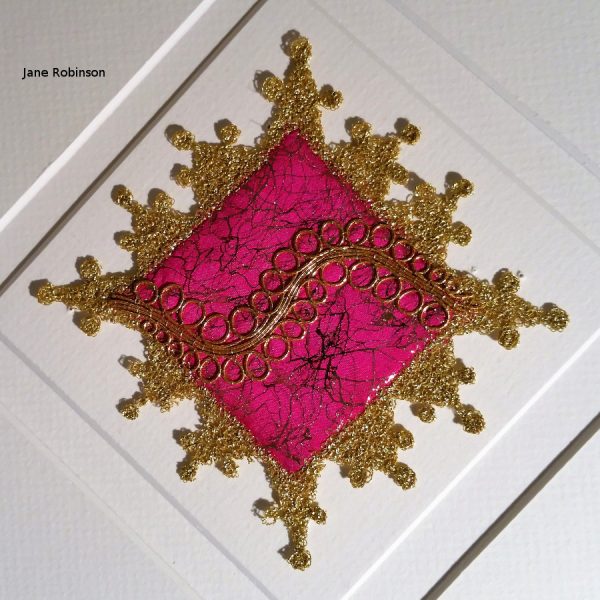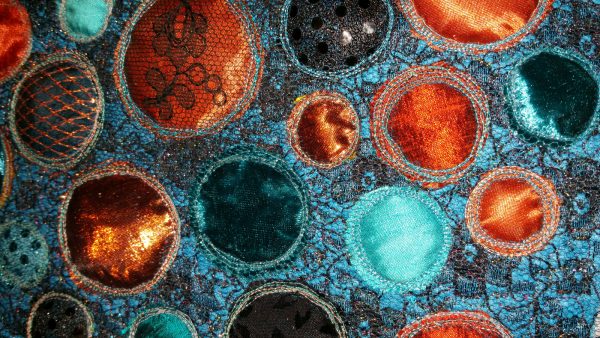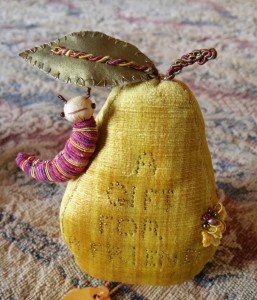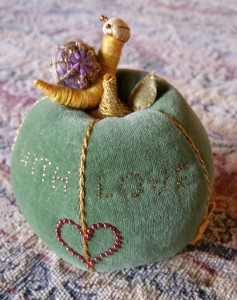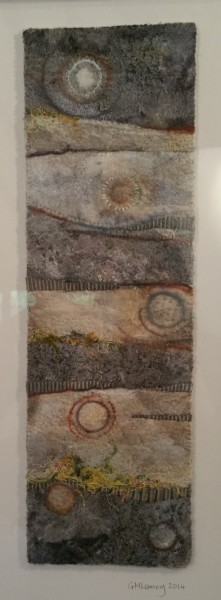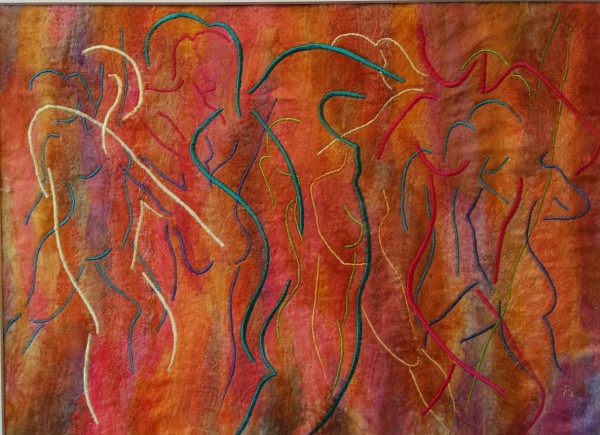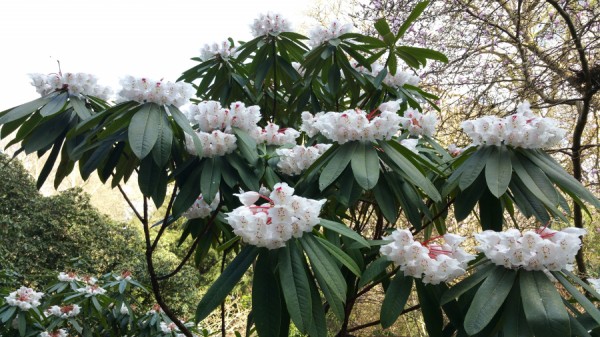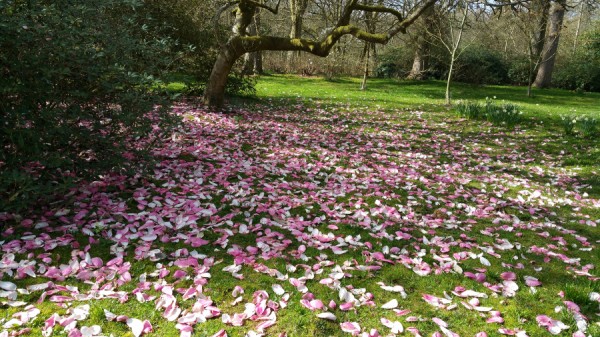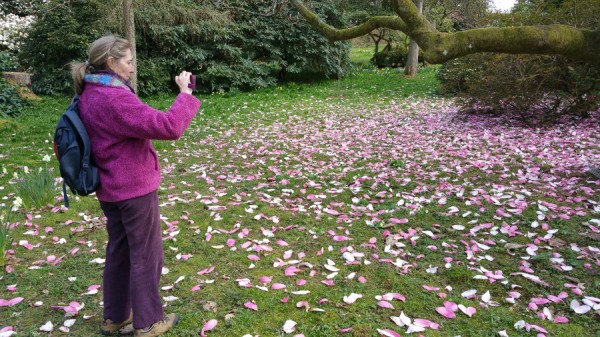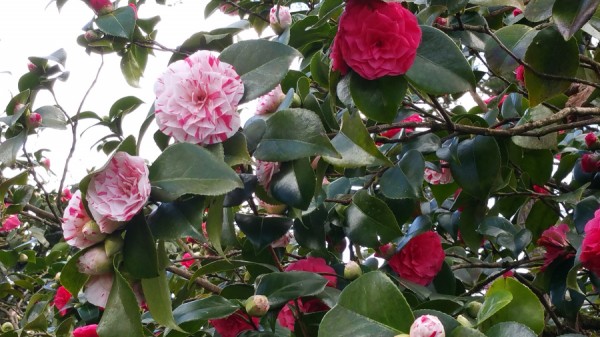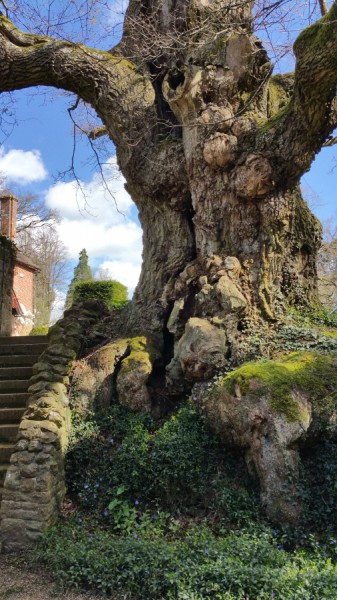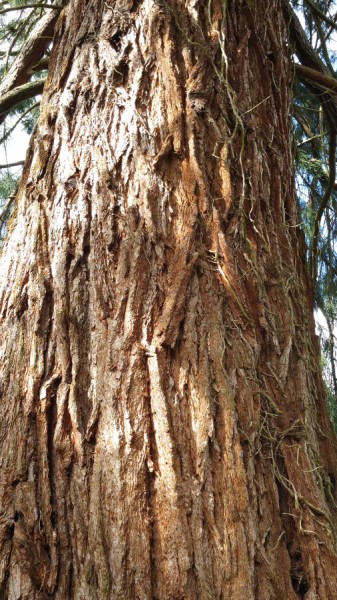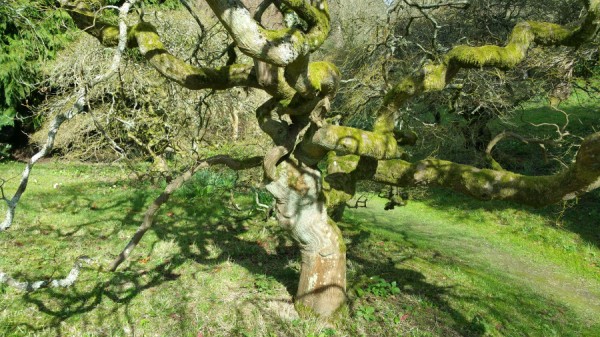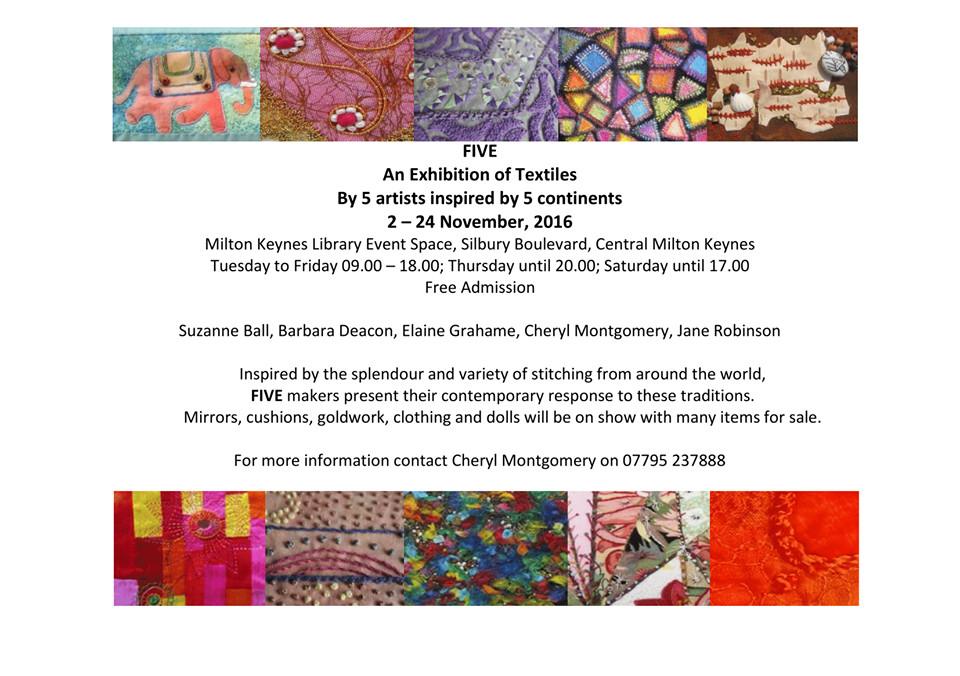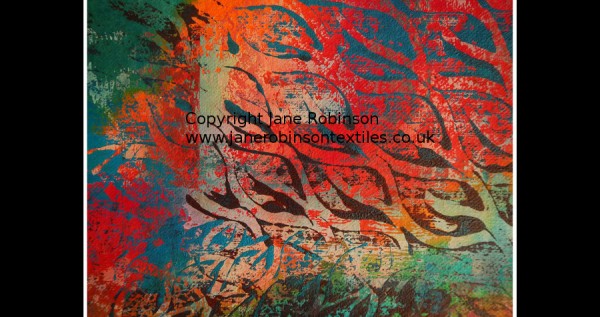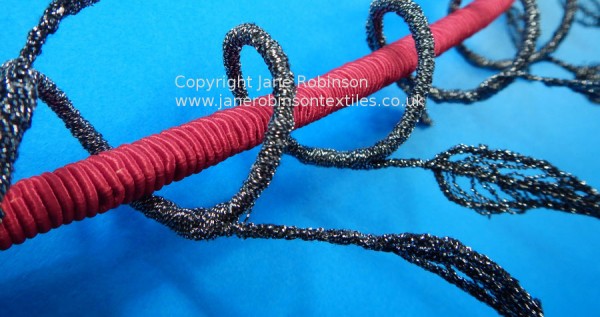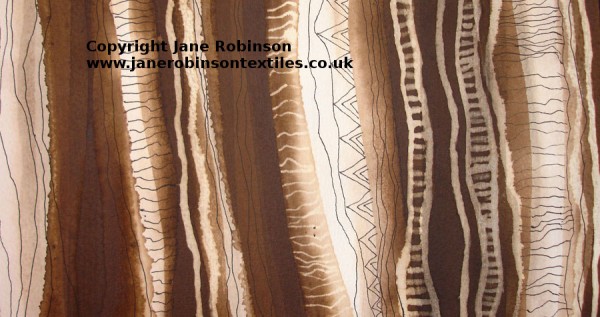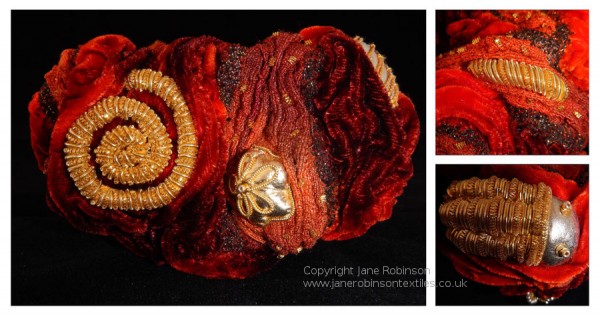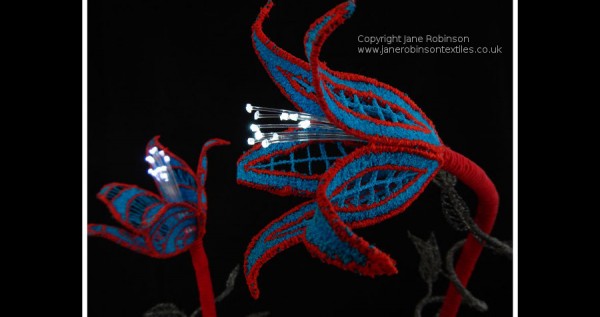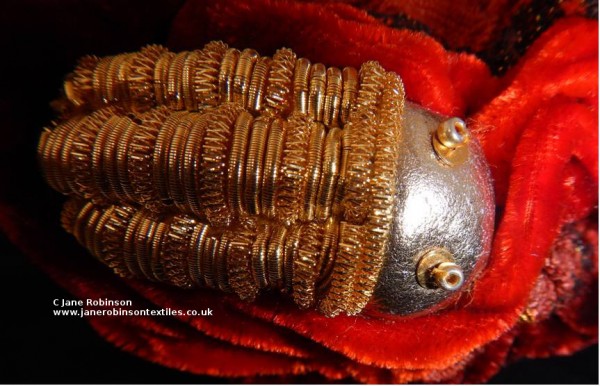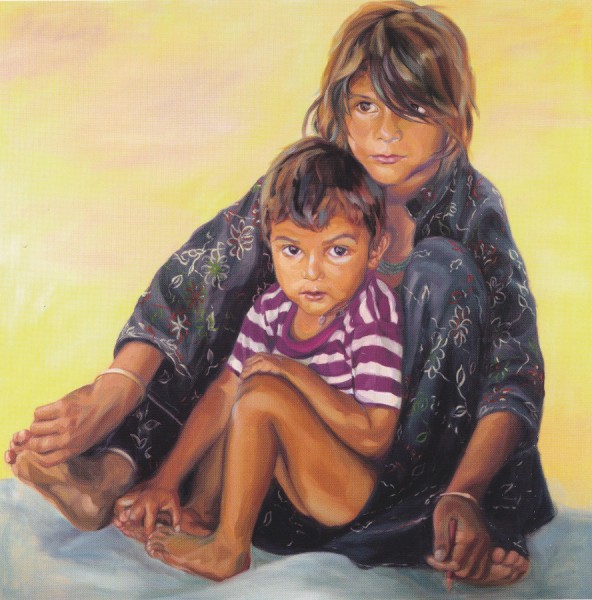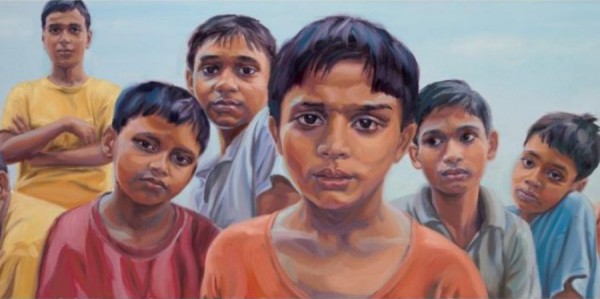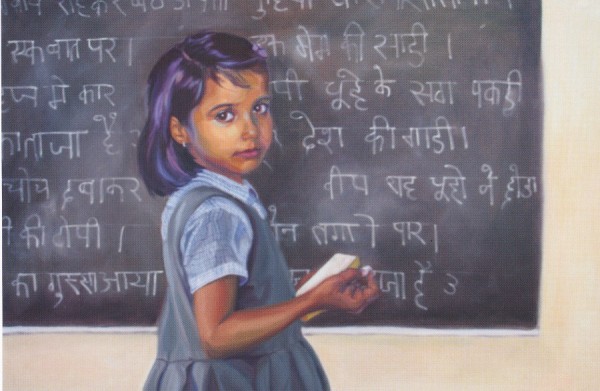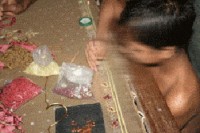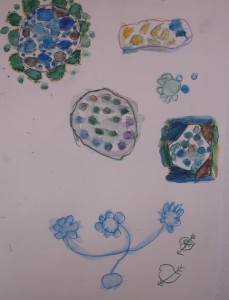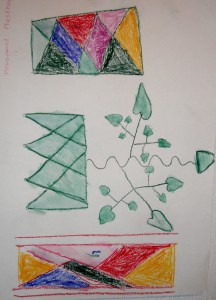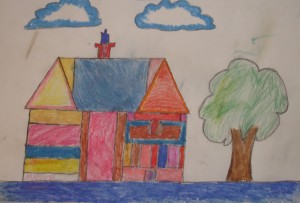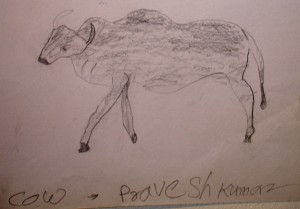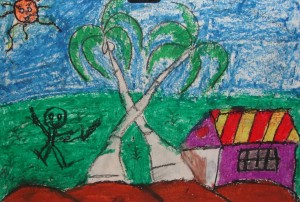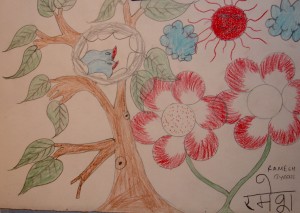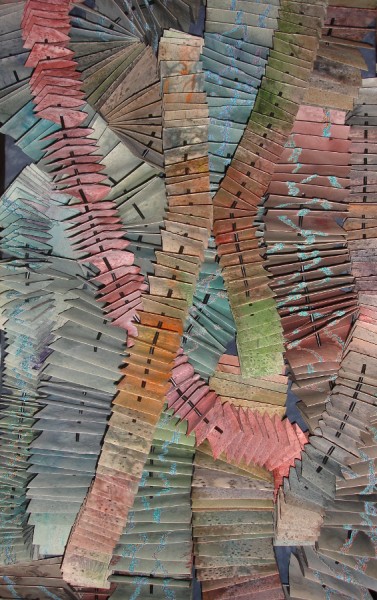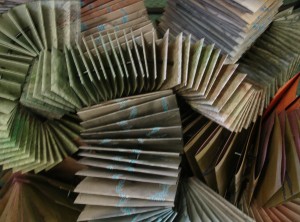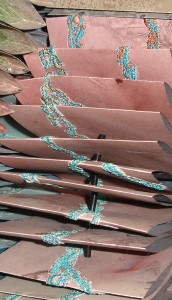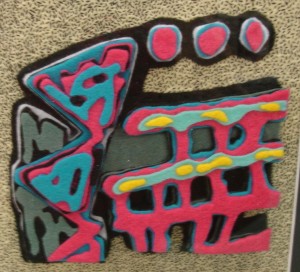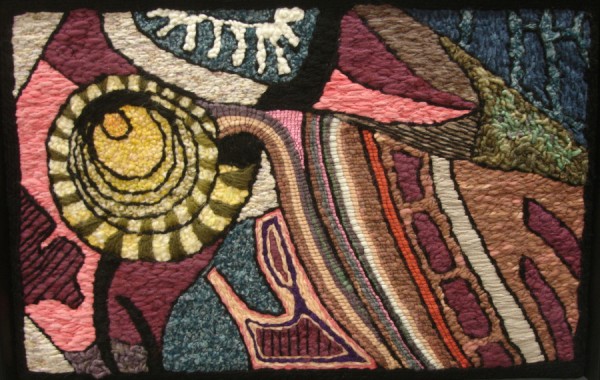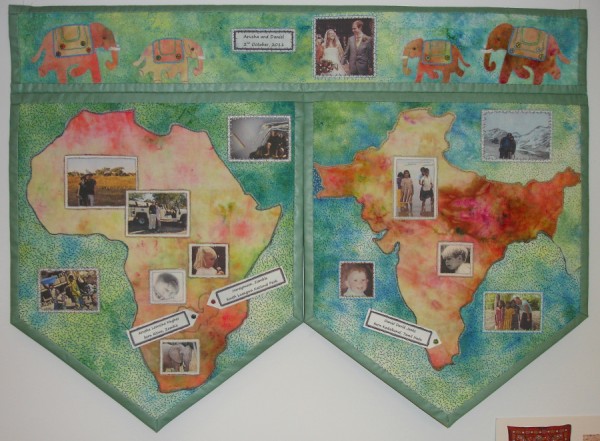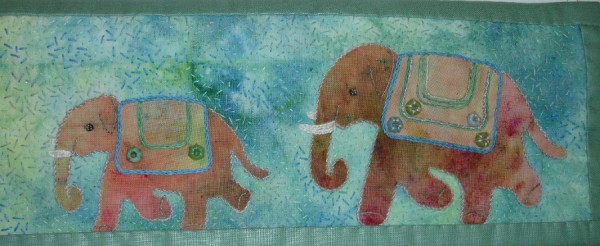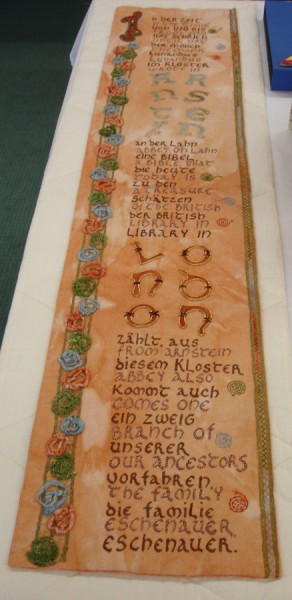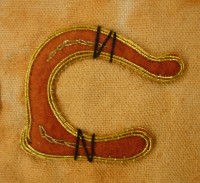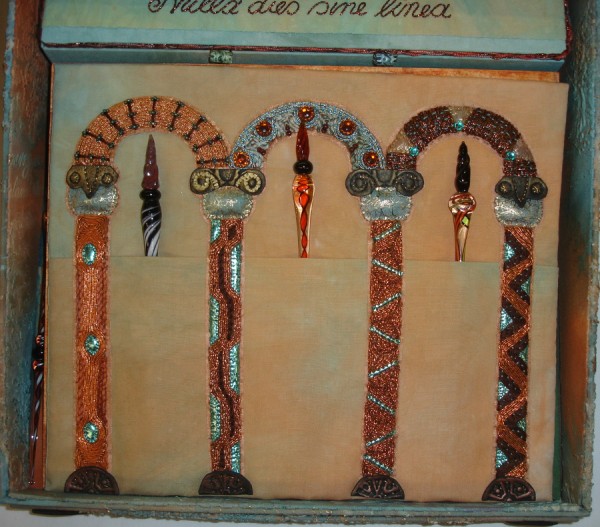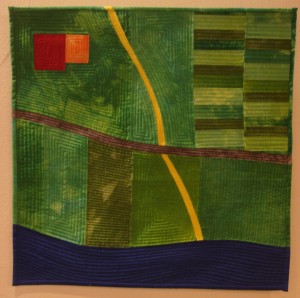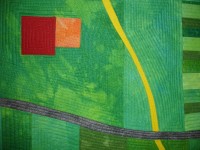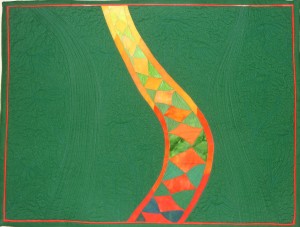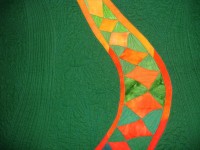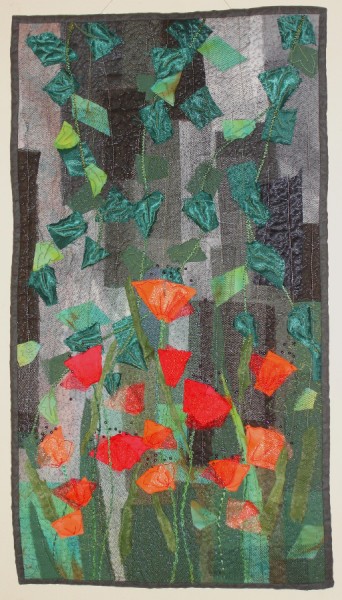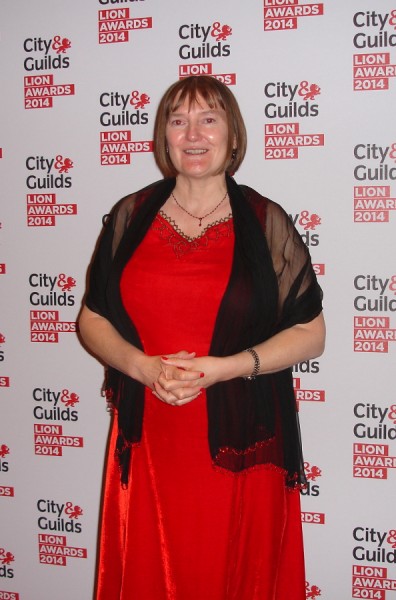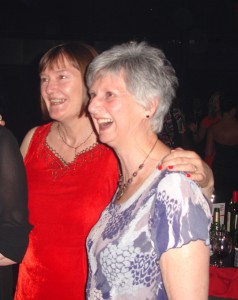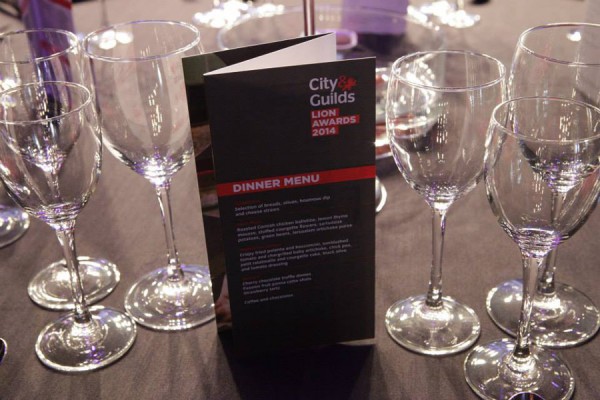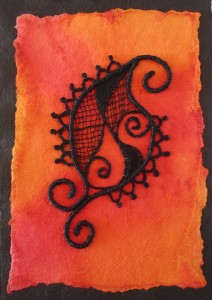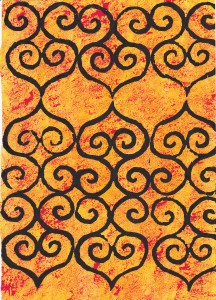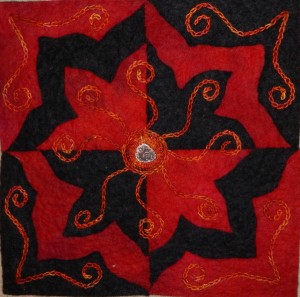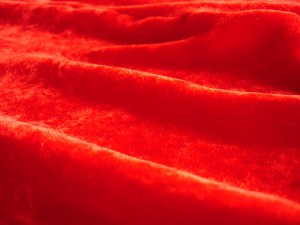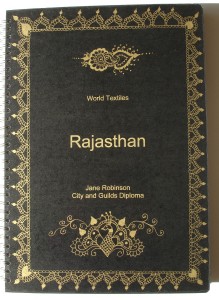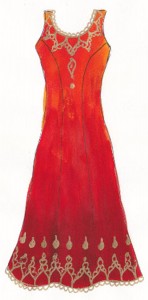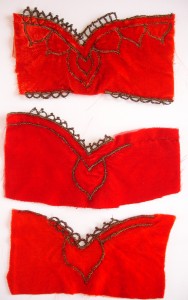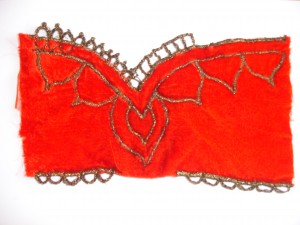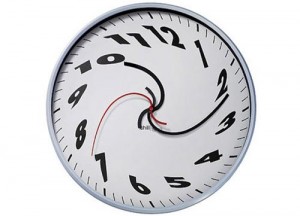Tag Archives: Embroidery
The Thread
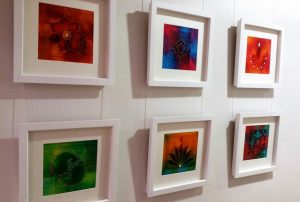 I’m currently taking part in a small textile art exhibition at the Roffey Park Institute near Horsham. Roffey Park has a new exhibition of art-work every 3 months, and this time they
I’m currently taking part in a small textile art exhibition at the Roffey Park Institute near Horsham. Roffey Park has a new exhibition of art-work every 3 months, and this time they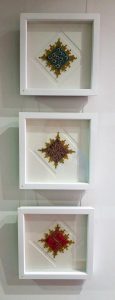 invited six local textile artists. It was good to meet other textile people while we were putting it up (supposedly silently, as
invited six local textile artists. It was good to meet other textile people while we were putting it up (supposedly silently, as 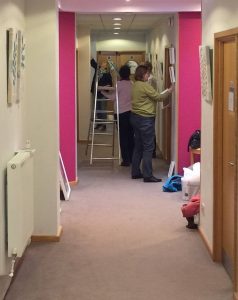 we were installing the art in the corridors while training courses were going on, although silence was hard to achieve once we got chatting). It was lovely to meet the other people exhibiting. If you’d like to visit, please phone the institute first as it’s a working environment.
we were installing the art in the corridors while training courses were going on, although silence was hard to achieve once we got chatting). It was lovely to meet the other people exhibiting. If you’d like to visit, please phone the institute first as it’s a working environment.
Here’s some lovely work by Isobel Moore and Diane Rogers (below). I’ve seen both their work online and in exhibitions, so it was nice to meet them ‘for real’.

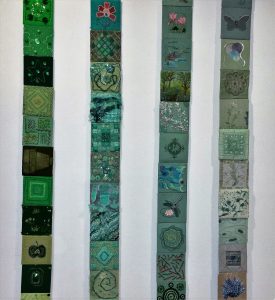 Also on display are the amazing ‘Rainbow hangings’ that were created by different Embroiderers Guild branches. There are 50 or so densely embroidered hangings, made up individually stitched squares of one colour, between them making a lovely rainbow-coloured collection. They were stitched by different Embroiderers Guild branches and put together as a collective exhibition that tours the country. Here are 2 close-up examples.
Also on display are the amazing ‘Rainbow hangings’ that were created by different Embroiderers Guild branches. There are 50 or so densely embroidered hangings, made up individually stitched squares of one colour, between them making a lovely rainbow-coloured collection. They were stitched by different Embroiderers Guild branches and put together as a collective exhibition that tours the country. Here are 2 close-up examples.
Last year…
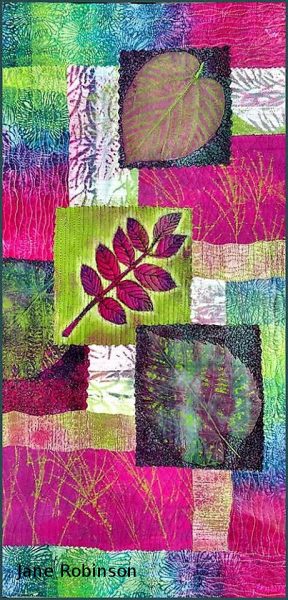 So many blog posts get partly written in my head, usually when I’m driving, when I have time to think about it but not actually do it……and then a month goes by, and another month…….
So many blog posts get partly written in my head, usually when I’m driving, when I have time to think about it but not actually do it……and then a month goes by, and another month…….
There’s always something else pressing, like ‘life and stuff’. I’ve been sucked into Facebook (a bit late to the party, resisting all the way, but now I’ve become quite an addict). And I think there’s also a loss of momentum with blogging, and wondering who is out there reading it. FB is so quick and immediate; just toss in a photo and a couple of sentences, and job’s a good’un. There’s an argument in my head between the appeal of the instant click and share, and the enjoyment of longer reflections and ramblings with time to explore thoughts and ideas. But if I always aim for longer reflections then this may be part of the reason why I don’t get round to doing it, so maybe I need to start again with shorter simpler posts. Anyway, to get started again I thought I’d just post some a few random photos of what I’ve been up to since my last post.
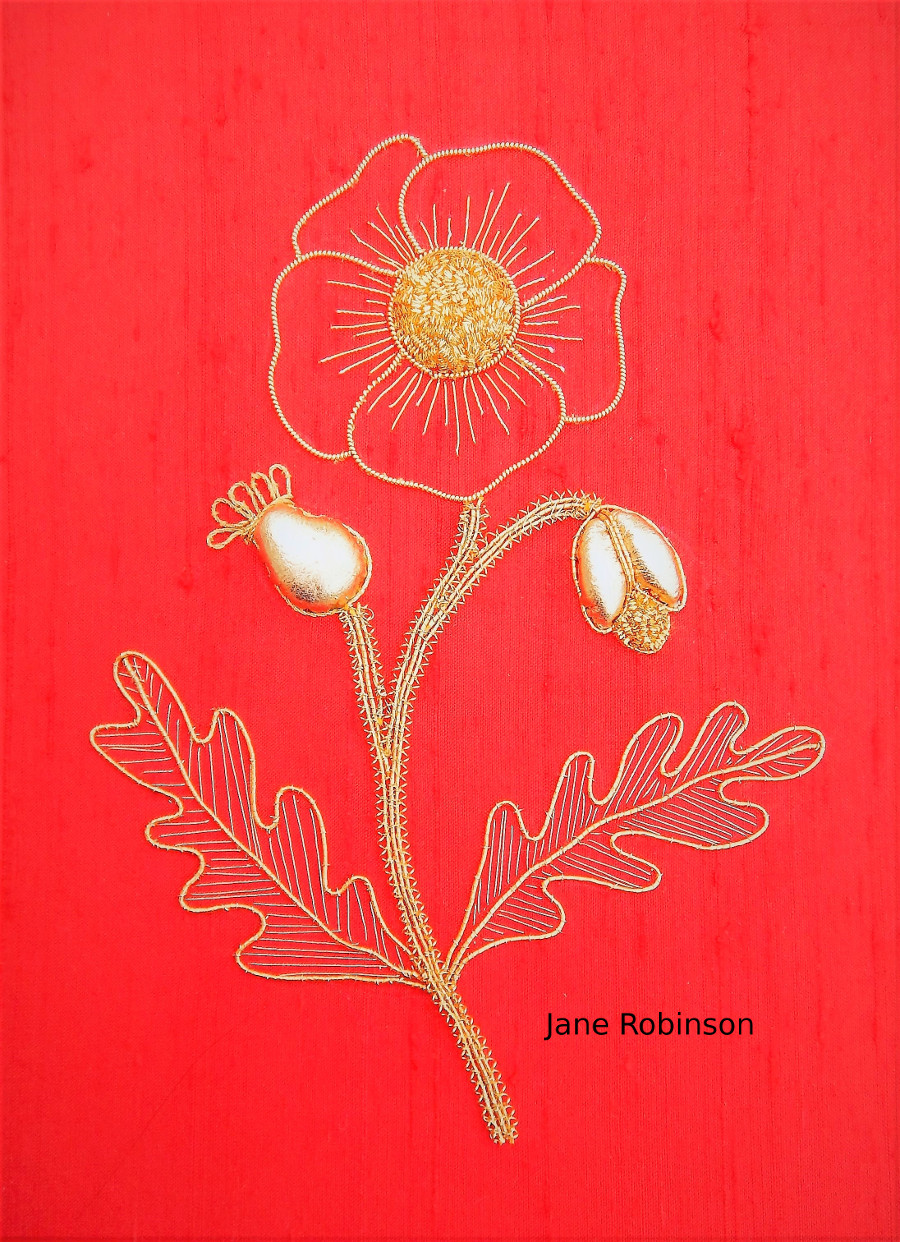
Goldwork poppy, my entry for the Embroiderers Guild ‘Page 17’ Exhibition. Each entry is inspired by Page 17 of a chosen book – in my case W Keble-Martin’s ‘The Concise British Flora in Colour’
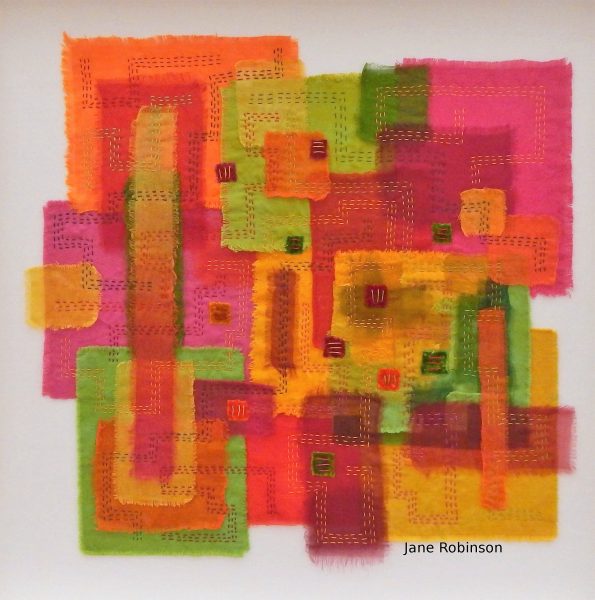
This is going back a bit now, but I think I posted it as work in progress but never put the finished thing on here.
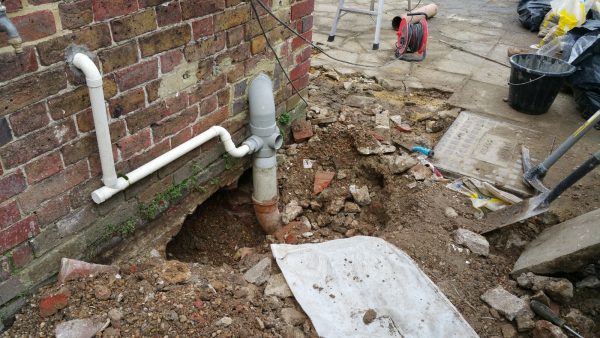
Unexpected holes under the house are very distracting. We are surrounded by a sea of mud, while the path and terrace are being drilled/dug up. It’s amazing how much time and energy these things absorb.
Oh, and another distraction is that I’ve been working on a new website for Worthing Tuesday Embroiderers Guild. It’s had more attention than my own website, so do check it out here.
That’s all for now. It would be great to know who reads this. I know from Google Analytics that people do visit, but I’d love to know who you are so do leave a comment. ‘Toodle Pip’.
Ramster Embroidery Exhibition 2017
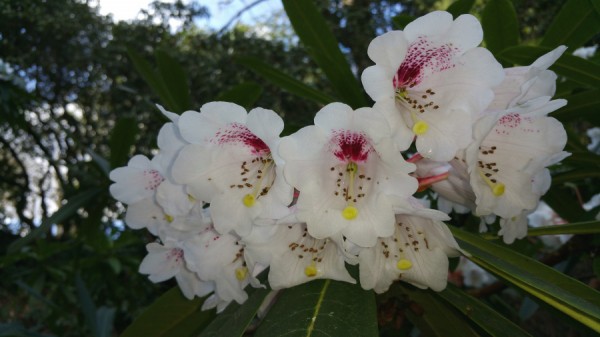 It has been great to take part in the Ramster Embroidery Exhibition 2017. Exhibiting alongside some well-known names is slightly daunting, but it’s been an enjoyable and friendly experience. It was wonderful to see so much textile art all together in one place – I think there were nearly 300 exhibits, by 120 different artists, and all so varied. I’ve picked out a few pieces here that I particularly liked.
It has been great to take part in the Ramster Embroidery Exhibition 2017. Exhibiting alongside some well-known names is slightly daunting, but it’s been an enjoyable and friendly experience. It was wonderful to see so much textile art all together in one place – I think there were nearly 300 exhibits, by 120 different artists, and all so varied. I’ve picked out a few pieces here that I particularly liked.
I love the pincushions above by Jane Cobbett. They are inspired by a Victorian pincushion although they remind me of the mad little silk-worms that are often featured in Elizabethan embroidery. I like the insane grin on the stripy one’s face. I also like the way the velvet pear looks kind of aged.
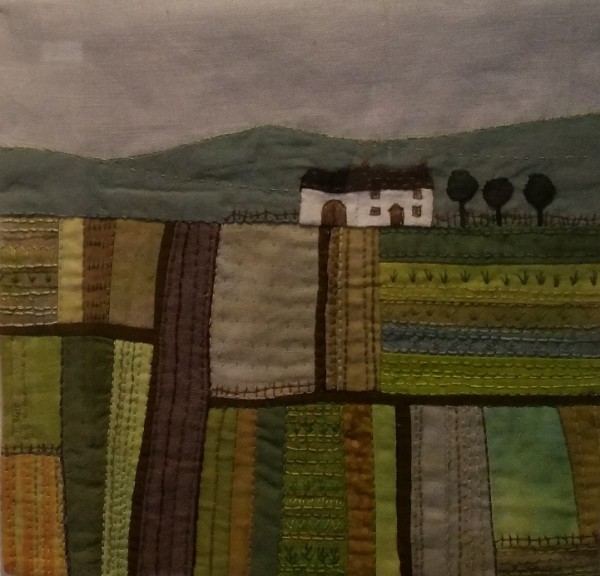 One of my favourites is ‘House in the Fields’ by Jane Mckeown. There’s something quite modest about it that appeals to me. Even though I have no idea where it is (maybe it’s not a real place at all), but my instant thought was ‘I know that place’. Maybe it reminds me of the small-holding in the Shropshire hills that my parents ran until I was three. It’s beautifully coloured and proportioned. I think it adds so much that the sky is grey not blue, and I love the rows of vegetables all carefully tended. I think it’s a lovely under-stated piece. See more of Jane’s lovely work here
One of my favourites is ‘House in the Fields’ by Jane Mckeown. There’s something quite modest about it that appeals to me. Even though I have no idea where it is (maybe it’s not a real place at all), but my instant thought was ‘I know that place’. Maybe it reminds me of the small-holding in the Shropshire hills that my parents ran until I was three. It’s beautifully coloured and proportioned. I think it adds so much that the sky is grey not blue, and I love the rows of vegetables all carefully tended. I think it’s a lovely under-stated piece. See more of Jane’s lovely work here
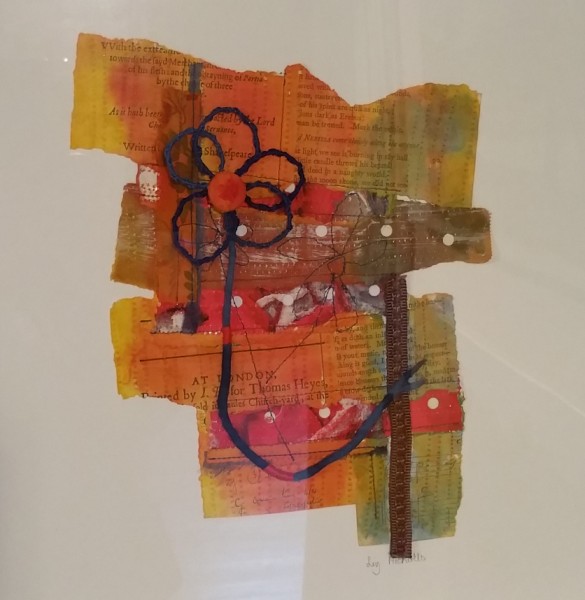 Above: Elizabeth Nicholls, Burning Embers. I like the colours and the freedom of this piece.
Above: Elizabeth Nicholls, Burning Embers. I like the colours and the freedom of this piece.
Above: Gillian Lamey, Seed Heads 2. This appeals to me because of it’s subtlety. The textures are wonderful (they don’t show up too well here due to the reflective glass, but in real life they’re lovely).
Rita Johnson, Inside the Dance, Embellishment and machine embroidery. I like the sense of movement in this, and the colours.
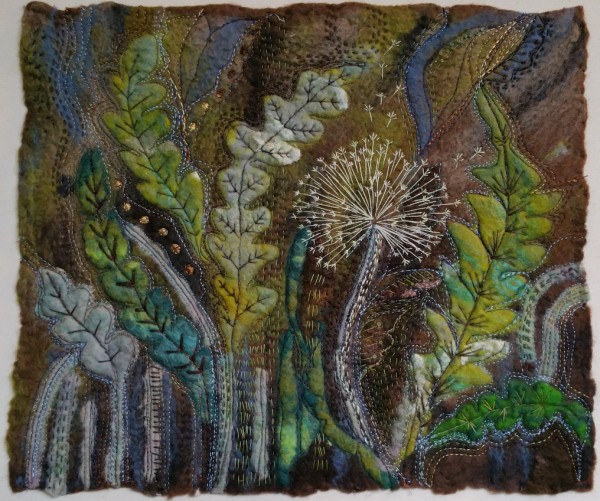 Above: Jacky Cardy. I treated myself to one of her lovely felted and embroidered bird brooches – I just couldn’t resist.
Above: Jacky Cardy. I treated myself to one of her lovely felted and embroidered bird brooches – I just couldn’t resist.
We took the opportunity for a walk round the beautiful Ramster gardens. The enormous flowering shrubs and trees are magnificent. Some of the magnolias have held their leaves and others had shed them into bright pink carpets (spot the colour coordination with my friend’s clothes!) Does anyone know what this amazing flowering tree is?
Unaccustomed as I am…
 I’ve given two talks in the space of a week. The first was to the Milton Keynes Embroiderers Guild which coincided with our new textile art exhibition there by ‘FIVE’ (here’s a photo of part of the exhibition – more about that in a later post). The second talk was to Wey Valley Workshop Textile Group in Godalming. I’m delighted to report that I actually enjoyed both of them! No need to lie down in a darkened room to recover, although that bottle of wine later on in the evening did hit the spot. Both groups were lovely and welcoming, and everyone was really friendly. I was pleased with the response to both talks, and I’ve been pondering over why I was apprehensive about it beforehand.
I’ve given two talks in the space of a week. The first was to the Milton Keynes Embroiderers Guild which coincided with our new textile art exhibition there by ‘FIVE’ (here’s a photo of part of the exhibition – more about that in a later post). The second talk was to Wey Valley Workshop Textile Group in Godalming. I’m delighted to report that I actually enjoyed both of them! No need to lie down in a darkened room to recover, although that bottle of wine later on in the evening did hit the spot. Both groups were lovely and welcoming, and everyone was really friendly. I was pleased with the response to both talks, and I’ve been pondering over why I was apprehensive about it beforehand.
Surveys asking what people worry about seem to suggest that fear of death only occupies the number two spot. Fear of public speaking comes in at number one. It’s that 3am kind of worry, when the house is silent, the dressing-gown hanging on the back of the door in the darkness is someone lurking silently in the shadows, and the people you are going to speak to the next day are definitely going to eat you.
I’ve done my share of giving evidence in Court for work, so I’m used to preparing myself for cross-examination by a hostile barrister whose purpose in life is to make you look stupid, or contradict yourself, or lose your thread, or burble. You do gradually learn the tricks that the barristers employ such as ‘The Withering Look’ or the facial expression that says ‘I Cannot Believe You’ve Just Said Something Quite So Stupid’. I have to remind myself that when I’m speaking to a textile group I am actually talking to a friendly group of like-minded people who have come along because they share the same interest in textiles, and who have come along in a positive spirit. Old habits die hard though, and it is lovely when I have got started and begin to realise that I’m not going to be eaten for breakfast. I start to see nods and smiles and no Withering Looks. The icing on the cake is that the questions are friendly and interested, not critical.
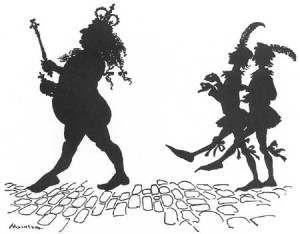 I think part of the apprehension is also an element of ‘So what do I know’. I get invited to do these talks on the strength of having won the C&G Gold Medal for Excellence in Stitched Textiles, rather than because of the years of exhibiting, teaching and publishing experience that many speakers have. I find myself thinking ‘If I had more years experience in textile art, then I would have more to say’. Let me confess something. Once, the night before giving evidence in Court, I dreamt that I was standing in the witness box dressed up in my formal Court clothes except that I had forgotten to put on my skirt. ‘Beam me up, Scotty!’ So, what actually is the worry? Being exposed, like the emperor in his non-existent new clothes? Being caught out? Being found lacking in some way? All of the above, I suspect. So it’s really exciting and liberating to have a positive response to my talks from these two lovely groups (and I’m pleased to say that I did remember to get dressed beforehand!)
I think part of the apprehension is also an element of ‘So what do I know’. I get invited to do these talks on the strength of having won the C&G Gold Medal for Excellence in Stitched Textiles, rather than because of the years of exhibiting, teaching and publishing experience that many speakers have. I find myself thinking ‘If I had more years experience in textile art, then I would have more to say’. Let me confess something. Once, the night before giving evidence in Court, I dreamt that I was standing in the witness box dressed up in my formal Court clothes except that I had forgotten to put on my skirt. ‘Beam me up, Scotty!’ So, what actually is the worry? Being exposed, like the emperor in his non-existent new clothes? Being caught out? Being found lacking in some way? All of the above, I suspect. So it’s really exciting and liberating to have a positive response to my talks from these two lovely groups (and I’m pleased to say that I did remember to get dressed beforehand!)
I based these talks on exploring questions about why adults so easily lose the creativity that they had when they were children, and how we can get it back if we do lose it. This is something I’ve thought about a lot, because it connects with both my professional working life and my re-discovery of creativity and textiles later on in life.
When I did two previous textiles talks last year I found it very distracting using written notes. It was like someone switching on a fan that blew all my ideas around into heaps of chaos. Those two talks definitely had some Grade A burbling! ‘The mind is a wonderful thing. It starts working the moment you are born and never stops until you stand up to speak in public’. (Roscoe Drummone). So this time I decided to use the digital images as the prompts instead, and to have no written notes at all. This worked much better, I think. It did occur to me that it would be good to have a Plan B in case of technical failure, but hey, they say adrenaline sharpens the mind.
I guess it will take some time until I lose the unnerving feeling that when I speak about textiles, people are secretly wondering why I forgot to get dressed! I’m not quite sure where the transition comes between being an enthusiastic amateur and being a professional artist. I have a kind of reverence for ‘proper’ textile artists – the ones who earn their entire living through their art. I’m coming into this quite late compared to the bright young things who emerge from art college, so I think I’ll just carry on bumbling along and developing my work and I’ll see where it takes me. In the meantime, with these latest two talks I feel I have dipped my toe into the water. I’m so pleased to find that the water was warm and there weren’t any crocodiles lurking below the surface.
‘FIVE’ are in Milton Keynes
We are moving our recent exhibition (together with some new work) up to Milton Keynes. We are showing stitched textile work inspired by the wonders of World Textiles. You will get get two exhibitions in one visit, because we are exhibiting alongside an Embroiderers Guild exhibition based on the work of garden designer Capability Brown. I’m working away on some new pieces for the new location. Will try to post some images but time is escaping – as it does – I think the world has sprung a leak somewhere, so the time dribbles out! I hope you can come and visit us at the new venue.
‘FIVE’ Exhibition is now open

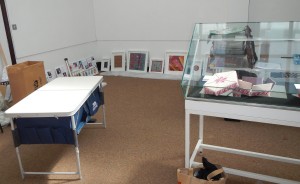
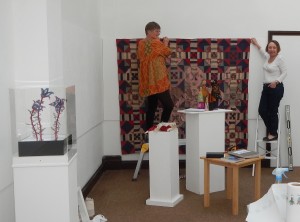
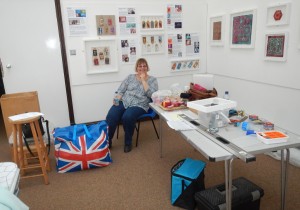
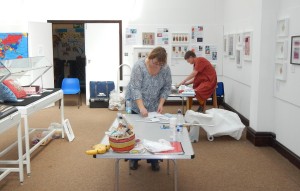 The ‘FIVE’ exhibition is now installed in Worthing. I’ve ‘disappeared’ from my blog for a while because of preparations for the exhibition, so I’m pleased to say it’s all hung and open to visitors now. There’s one photo above of a finished section, and I’ll add more photos of the final installation when I’ve taken some in better light.
The ‘FIVE’ exhibition is now installed in Worthing. I’ve ‘disappeared’ from my blog for a while because of preparations for the exhibition, so I’m pleased to say it’s all hung and open to visitors now. There’s one photo above of a finished section, and I’ll add more photos of the final installation when I’ve taken some in better light.
In the meantime, here are some photos of ‘work in progress’ while we were hanging the work. We did have a few ‘headless chicken’ moments, but we were OK once we’d worked out a ‘grand plan’ of what was going where before getting down to details. There’s so much to organise in advance, down to the minutest details like the size and length of screws needed, where to source plinths from, publicity and writing Artist Statements etc. Working out a ‘house style’ was well worth the time invested, to give some continuity for labels etc.
The ‘team’ all stayed at my house during the 3 days of installation as I’m the only one local to the exhibition. I have to admit, by the time we were kicked out of the gallery each day at closing time we were ready for a glass of wine or three. My husband is now convinced that textiles are just a ‘cover’ for an eating and drinking group. Mind you, having just taken out the recycling I can see why he thinks that!
We’re at The Studio Gallery at Worthing Museum and Art Gallery, Chapel Road, Worthing BN11 1HP. If you’re planning to come over, then a good time to come would be this Saturday, 14th May between 2 and 5pm. That’s the one time when all five of us will be there so we’d love to see you then. Otherwise, we’re open until May the 21st, from Tuesday-Saturday, 10.00am to 5.00pm. Do come to see us if you can. Here’s a sneak preview below of part of the room in a panoramic shot.
Bling
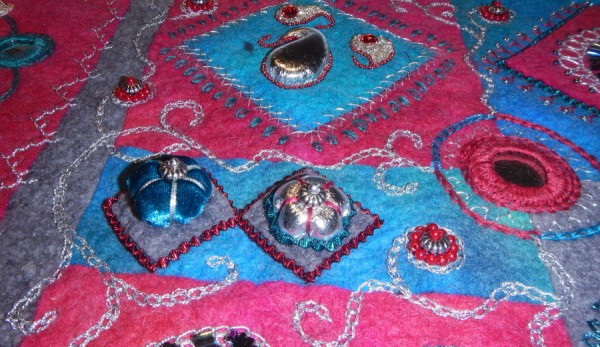 There’s something about the sparkle of metal thread that keeps drawing me back to it. Perhaps I was a magpie in a former life? Here’s an update on the piece that I was working on some time ago, based on motifs from Indian textiles.
There’s something about the sparkle of metal thread that keeps drawing me back to it. Perhaps I was a magpie in a former life? Here’s an update on the piece that I was working on some time ago, based on motifs from Indian textiles. 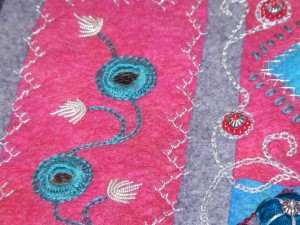 I’ll just show you some details rather than the whole finished piece, because it will be going into our exhibition in May – but once it is up on the wall then I’ll post pictures of the finished thing. I’m working on several other pieces alongside it, but this particular one has been quite time-consuming so it’s good to see it finally coming together. I really wanted to do something that was purely decorative and not ‘conceptual’ in any way. I prefer not to use an embroidery hoop where I can avoid it, so working on thick felt makes that easier as it isn’t too floppy. Unfortunately it makes it hard to photograph. Something about the way felt absorbs light seems to drain the colour out of the photo, so it either looks dull or harsh. The colours are better in real life, honest! I’ll post some of the other pieces that I’m working on in another post quite soon.
I’ll just show you some details rather than the whole finished piece, because it will be going into our exhibition in May – but once it is up on the wall then I’ll post pictures of the finished thing. I’m working on several other pieces alongside it, but this particular one has been quite time-consuming so it’s good to see it finally coming together. I really wanted to do something that was purely decorative and not ‘conceptual’ in any way. I prefer not to use an embroidery hoop where I can avoid it, so working on thick felt makes that easier as it isn’t too floppy. Unfortunately it makes it hard to photograph. Something about the way felt absorbs light seems to drain the colour out of the photo, so it either looks dull or harsh. The colours are better in real life, honest! I’ll post some of the other pieces that I’m working on in another post quite soon.
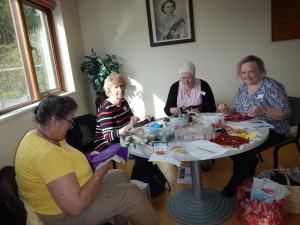
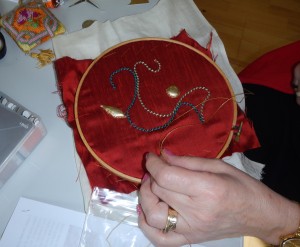 On the subject of bling, I ran a day workshop on goldwork last week for the West Sussex Federation of Women’s Institutes. They have regular craft days that are open to all the different local branches. It’s an opportunity to get together and learn something – and yes, some stitching did go on in between the chatting! I enjoyed teaching such a friendly and welcoming group, and their enthusiasm was lovely. I offered the choice of working from my design, or ‘going off-piste’ and working more spontaneously. Three people chose to work from the design and nine chose to work spontaneously. I have seen people getting quite stressed with goldwork because of the emphasis on ‘perfection’ and the difficulty of achieving that in the early stages. It’s hard to try to produce something perfect when you’re learning the techniques, and the traditional plain silk backing really emphasises any little mistakes. The idea of doing it more ‘free-form’ is to let the materials dictate the shapes, so that there is no ‘right or wrong’ place to position each piece. As I explained, the design did not need to be any more challenging than starting with a zig-zag or a wiggle, then letting those develop to complement the first lines, and then filling in spaces. Several people produced pieces that looked quite ‘art nouveau’ in their shapes, because they let the materials ‘flow’ quite naturally.
On the subject of bling, I ran a day workshop on goldwork last week for the West Sussex Federation of Women’s Institutes. They have regular craft days that are open to all the different local branches. It’s an opportunity to get together and learn something – and yes, some stitching did go on in between the chatting! I enjoyed teaching such a friendly and welcoming group, and their enthusiasm was lovely. I offered the choice of working from my design, or ‘going off-piste’ and working more spontaneously. Three people chose to work from the design and nine chose to work spontaneously. I have seen people getting quite stressed with goldwork because of the emphasis on ‘perfection’ and the difficulty of achieving that in the early stages. It’s hard to try to produce something perfect when you’re learning the techniques, and the traditional plain silk backing really emphasises any little mistakes. The idea of doing it more ‘free-form’ is to let the materials dictate the shapes, so that there is no ‘right or wrong’ place to position each piece. As I explained, the design did not need to be any more challenging than starting with a zig-zag or a wiggle, then letting those develop to complement the first lines, and then filling in spaces. Several people produced pieces that looked quite ‘art nouveau’ in their shapes, because they let the materials ‘flow’ quite naturally.
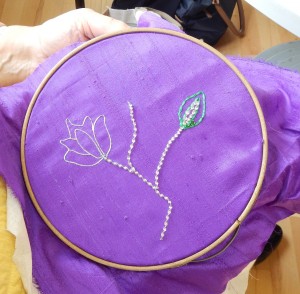 Working like that isn’t everyone’s cup of tea, and I did explain that it was abit of an experiment, but I was impressed that so many were willing to give it a go. The people who worked from a design also produced some pleasing results.
Working like that isn’t everyone’s cup of tea, and I did explain that it was abit of an experiment, but I was impressed that so many were willing to give it a go. The people who worked from a design also produced some pleasing results.
Now I must focus on finishing off the half-done pieces for the exhibition in May. Just to remind you, it’s from Fri 6th May to Sat 21st May (Tuesday to Saturday) 10.00 to 5.00, at The Studio Gallery at Worthing Museum and Art Gallery. See the ‘FIVE’ page on this website for more details.
‘FIVE’ Exhibition
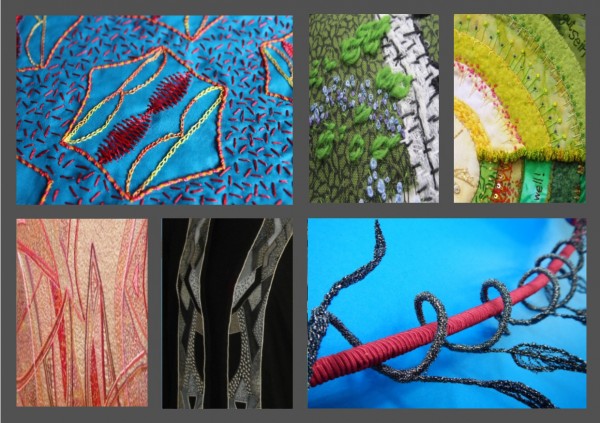 I’m pleased to tell you about our new exhibiting group, ‘FIVE’. We’re a group of textile artists (yes there are five of us – how did you guess?!) who have joined together as an exhibiting group. We met through the City and Guilds Diploma course in Stitched Textiles at Missenden Abbey, and became firm friends through our shared love of everything to do with textiles. How lucky you are if you stumble across people with shared interests, and what a joy it is to support and encourage each other along our textile journey.
I’m pleased to tell you about our new exhibiting group, ‘FIVE’. We’re a group of textile artists (yes there are five of us – how did you guess?!) who have joined together as an exhibiting group. We met through the City and Guilds Diploma course in Stitched Textiles at Missenden Abbey, and became firm friends through our shared love of everything to do with textiles. How lucky you are if you stumble across people with shared interests, and what a joy it is to support and encourage each other along our textile journey.
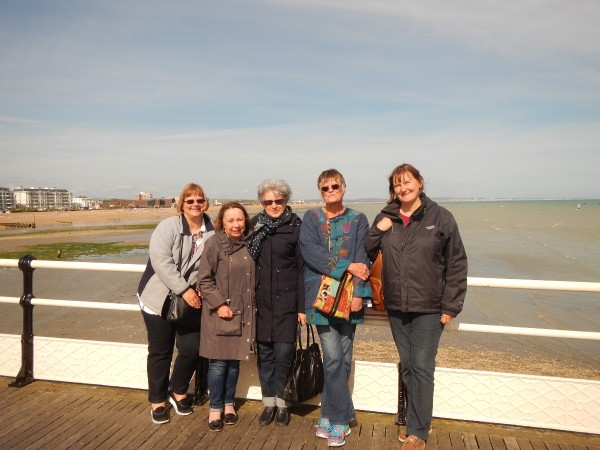 We all felt ready for a new challenge, so we decided to plan a joint exhibition of textile art. We all love the rich variety of world textiles, which we studied in some depth during our course, and it left us buzzing with new ideas for designs. For this reason we decided to base our first exhibition on World Textiles. The starting point for each piece is something from the world textiles that we love. It may be a colour combination, a pattern, a shape or function, or it may just be a texture.
We all felt ready for a new challenge, so we decided to plan a joint exhibition of textile art. We all love the rich variety of world textiles, which we studied in some depth during our course, and it left us buzzing with new ideas for designs. For this reason we decided to base our first exhibition on World Textiles. The starting point for each piece is something from the world textiles that we love. It may be a colour combination, a pattern, a shape or function, or it may just be a texture.
We’re all working on very different things. I’m working on a series of Indian-inspired panels, using the bright colours and the ‘sparkle’ of Indian textiles. Barbara is working on cushions, some of which are inspired by the subtleties of English embroidery. Elaine is making a series of embroidered mirrors that each reflect the colours and motifs of different continents, all so very different from each other. Suzanne is working on a hand-felted and embroidered jacket in the vibrant and exciting colours and patterns of Guatemala. Cheryl’s ‘family of stitched dolls’ represent family groups from different countries and cultures who are uprooted from one country to another, and the journey they go on as they move from a familiar culture to a new one. They are currently travelling the country, and the people ‘hosting’ them are writing different entries in their travel journal. It will be interesting to see what has appeared in the journal by the time they reach Worthing in May.
It’s an exciting and challenging experience putting on our first exhibition outside the more ‘sheltered’ confines of end-of-course shows. It’s all very exciting – I’ll keep you posted.
Work in progress
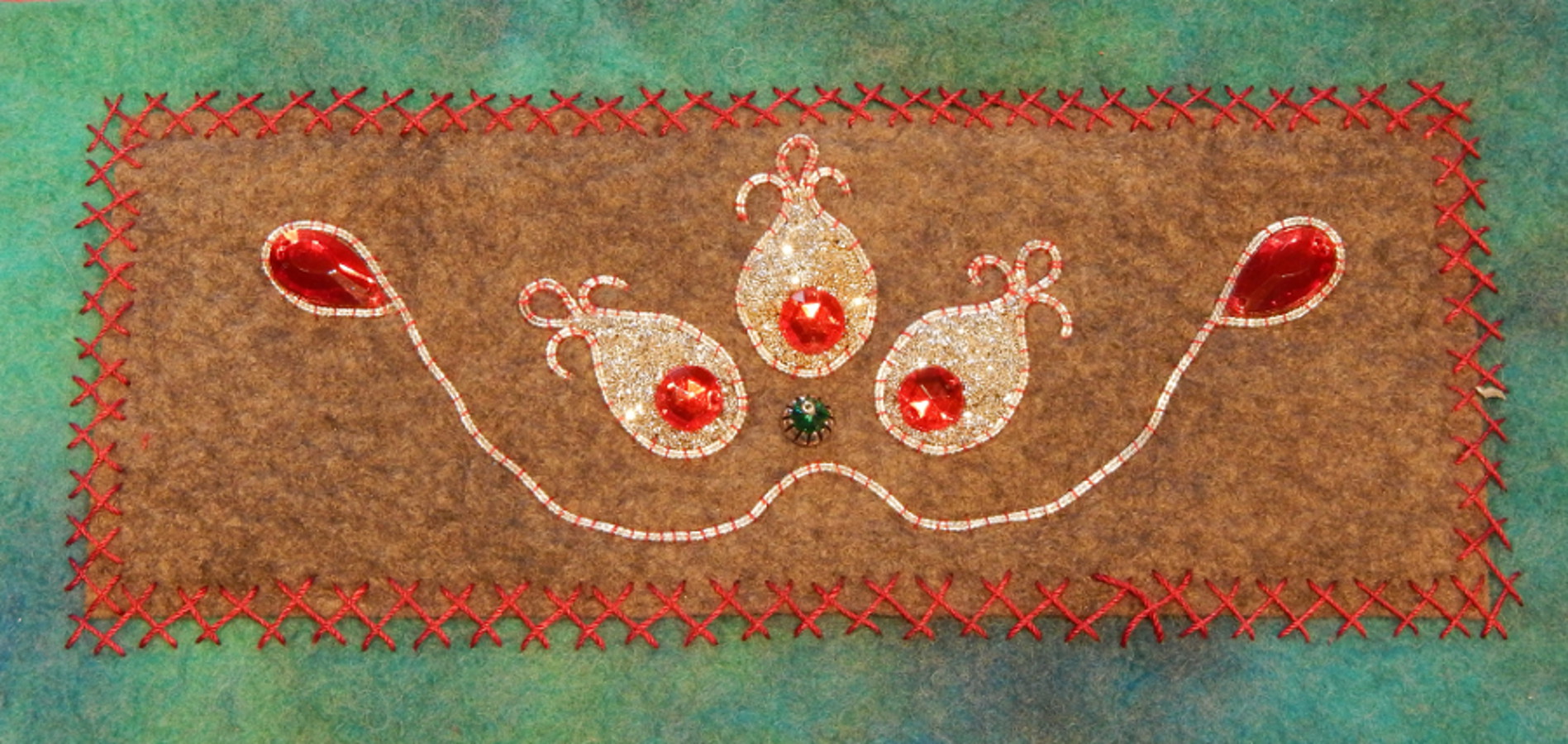
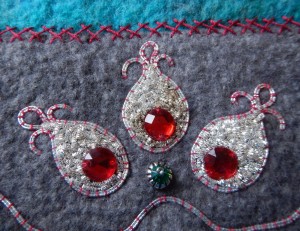
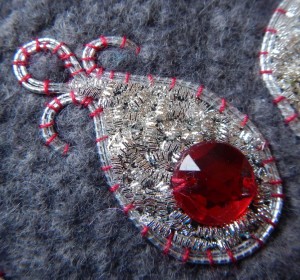 Here’s the latest piece of the ‘hand-stitched Indian doodles’ panel that I’ve been working on. This is another panel that will form part of the wall-hanging that I showed in my last post ‘Hand-stitched Indian Doodles’. I thought I’d add a couple of photos here, to show you ‘work in progress’.
Here’s the latest piece of the ‘hand-stitched Indian doodles’ panel that I’ve been working on. This is another panel that will form part of the wall-hanging that I showed in my last post ‘Hand-stitched Indian Doodles’. I thought I’d add a couple of photos here, to show you ‘work in progress’.
The background is pieced and patched dyed felt, in grey, red and greeny-blue, and the embellishment is added with a combiniation of silver metal-thread techniques, beading, and hand-stitch. This particular panel has an outline in couched silver ‘jap’, with cut-glass beads and a filling of ‘rough check’ cut into pieces and applied like beads. What I can’t capture in a photograph is that it reflects light and sparkles, especially aongside the other shiny bits of the other panels. When the piece is finished I’ll set it up in better light and try to take some pictures with a better colour balance and focus.
It’s slow work, but very absorbing. I must admit, I do wonder what I was thinking when I decided on the overall size. Metal thread work is lovely to do, but very time-consuming so it’s really better to stick to something teeny-tiny (note to self for next time!)
Another reason for slow progress is the impact of building and decorating work, and the dust and chaos that it brings. I’ve also had some pretty major dentistry this week (bone augmentation – but that’s probably enough info in case anyone reading is dentophobic!) But one good thing about this is that I have strict instructions not to over-exert myself or put my head upside down. I’m not sure how long I’ll get away with the argument that making cups of tea is exertion! But it definitely excludes sanding floors and painting ceilings, so I have the perfect excuse to snuggle up in the warm and get on with some embroidery. Every cloud has a silver lining, in this a case silver metal thread lining.
Creative Waves, Art on the Pier at Worthing
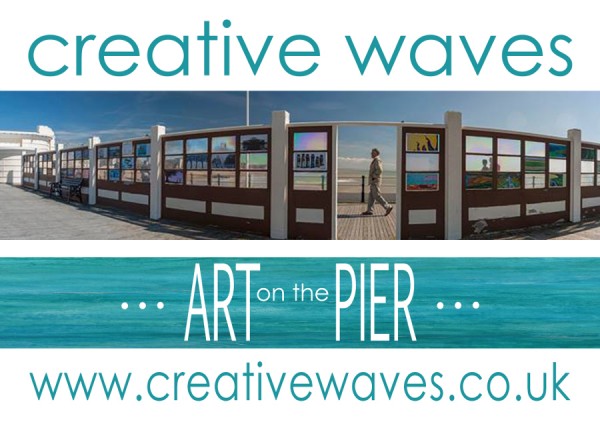 I’m really pleased that five of my pieces have been chosen to feature in a ‘community art’ project on Worthing Pier. The Creative Waves project has been going for several years now. It features the work of artists from the Worthing and Adur area, on panels along the pier. The images are printed onto specially treated vinyl which is resistant to UV damage, and they are mounted between glass panels that run down the centre of the pier. They stay there for a year and they seem to stand up to all the wind, salt, rain and blazing sun that comes their way. The west side will feature one piece each from 50 artists, and the east side will feature five pieces each from ten artists. The images on each side are mounted ‘back to back’ so that other panels can still looked through as windows. I like the very broad interpretation they give to ‘art’ – as well as paintings and drawings, they also feature silver-smithing, sculpture, embroidery, felting, printing and photography, amongst others. They also include lots of images from local children. Wow, if I’m pleased to have my work there, just imagine how exciting it would be if you were a young child! You can read more about the project here. I’ve just received the proofs (see below) of the images that were chosen (if you’ve looked at the Gallery pages here then you may recognise them). Worthing pier is a short stroll from my house and it will be quite surreal to see my own work there when we go down for an afternoon tea or an evening drink. How exciting!
I’m really pleased that five of my pieces have been chosen to feature in a ‘community art’ project on Worthing Pier. The Creative Waves project has been going for several years now. It features the work of artists from the Worthing and Adur area, on panels along the pier. The images are printed onto specially treated vinyl which is resistant to UV damage, and they are mounted between glass panels that run down the centre of the pier. They stay there for a year and they seem to stand up to all the wind, salt, rain and blazing sun that comes their way. The west side will feature one piece each from 50 artists, and the east side will feature five pieces each from ten artists. The images on each side are mounted ‘back to back’ so that other panels can still looked through as windows. I like the very broad interpretation they give to ‘art’ – as well as paintings and drawings, they also feature silver-smithing, sculpture, embroidery, felting, printing and photography, amongst others. They also include lots of images from local children. Wow, if I’m pleased to have my work there, just imagine how exciting it would be if you were a young child! You can read more about the project here. I’ve just received the proofs (see below) of the images that were chosen (if you’ve looked at the Gallery pages here then you may recognise them). Worthing pier is a short stroll from my house and it will be quite surreal to see my own work there when we go down for an afternoon tea or an evening drink. How exciting!
Workshop On The Web Article
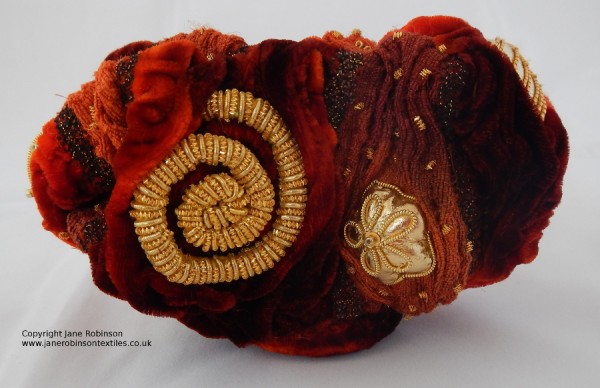
Jane Robinson 3D Goldwork Fossil Rock
I’m pleased to say that I’ve just had an article published in the on-line magazine ‘Workshop on the Web’ (Edited by Maggie Grey). I am a subscriber to Workshop on the Web and have enjoyed many a good article and workshop, so I was delighted to be invited to contribute. I was asked to write about one of my finished pieces in the Diploma in Stitched Textiles (Embroidery) course exhibition, which Sam Packer for WoW had seen last year. I had put this piece into the Festival of Quilts (Quilt Creations Category) this summer, so it seemed a good idea to choose this one. The article is split into two parts – the first covers piecing and patching the fabrics and dyeing them, and the second covers adding the gold-work fossils and manipulating it into a 3D piece.
What I couldn’t show in the article is that the rock is designed to ‘levitate’ and float in the air. To see it floating, click here.
If you’re not already a subscriber to Workshop on the Web (or WoW as people call it) then I do recommend it – not only because I’m in it!
Reclaiming Childhood
Last week I went to the opening night of an exhibition of paintings by Claire Phillips, a Sussex portrait artist, at the Oxo Tower in London. The title of the exhibition is ‘Reclaiming Childhood: Face To Face With Child Labour In India’. For several years Claire has worked with the charity ‘Bachpan Bachao Andolan’, which is a charity that rescues children from slave-labour in India. Some of the children come from factories and from domestic service. Many come from embroidery sweat-shops, where they have been stitching for hours and hours each day. They have no education, no health-care, no freedom, no time to play, and no kindness. If they fall asleep while working they are beaten. If they cry, they are beaten. They can’t see any way out or any future. Children are particularly desirable to embroidery sweatshops; they have good eyesight, nimble fingers, and can do detailed work that is more challenging for adults. One particular irony in India is that the numbers of children who are estimated to be in bonded labour instead of education is roughly equivalent to the number of adults who are out of work. This is the cost of the cheap embroidery that we buy in the West.
As embroiderers we know just how long it takes to hand-stitch sequins, or to do exquisite metal-thread work, or to stitch on tiny beads. How often do we buy a piece of embroidered clothing, or a bag or scarf, which has been hand-stitched in India? When we do, how often do we stop to ask ourselves why it is so incredibly cheap? Why not apply a quick bit of logic. Start with the price we pay, and subtract the cost of the shop that we bought it from (staff, premises, business rates etc). Subtract the cost of handling and shipping it across the sea from India. Subtract the cost of the wholesaler in India. Subtract the cost of transporting it within India. On top of the costs at each stage, add a profit margin. Once you have taken off all that, what is left? Peanuts. In that case, how can the person at the very end of the chain, the person who stitched it, possibly have been paid a decent living wage? And how likely is it that this person was a child?
The lucky ones are rescued by the charity. Some are returned to parents, and others stay in children’s homes run by the charity. Here they receive care and kindness, proper food, education and time to play. They learn to trust people; they learn hope, and they learn that they can have a future.
The sound-track and the written commentary to the exhibition tell us about the conditions that some of the children were rescued from, and the painful stories that led to their exploitation. However, the exhibition is lighter in spirit than I expected. The paintings show the children just as children, as Claire met them; playing, playful, exploring, mischievous, and fun. These are children who have a second-chance at childhood. It takes them time to learn to trust the adults around them – but once they do, their sense of fun is tremendous.
The art on one wall is a poignant reminder of what these children have lost and regained. There are two sets of pictures done by the children; the first set is soon after they are rescued, when their drawings tend to be timid and unconfident. Some, like the ones below, show details of the embroidery work they had to do for hours – in this case Zari (goldwork).
Other pictures are done by children who have been at the centre for longer and who have started to experience the world as free children should be able to experience it. These pictures fill the page with expressive, joyful images of the world around them; houses, the sun, a cow, or flowers. They have recovered a sense of childhood that most western children can take for granted.
The exhibition is on at The Oxo Tower until the 20th July, and will be at Worthing Museum and Art Gallery from 13th September 2014 until the 24th January 2015. Do go and see it if you can.
For more information on the charity, go to http://www.bba.org.in/
For more on Claire’s art, go to http://www.clairephillips.com/
There is also a talk by Kailash-Satyarthi at the Oxo Tower on the closing day of the London exhibition (20th July). Kailash is rated as one of the top human rights defenders of the world today. He and his colleagues literally risk their lives in the process of freeing enslaved children, and they have rescued around 80,000 children. In the painting by Claire (bottom left) he is pictured with some of the children rescued by Bachan Bachao Andolan. They are having a school lesson, something taken for granted by western children.
http://www.oxotower.co.uk/events/talk-human-rights-defender-kailash-satyarthi/
Thank you to Claire Phillips for permission to include images of her work on this blog.
Missenden Abbey Diploma shows
The Missenden Abbey Open Day last weekend was a wonderful display of work across a range of different subjects. There were tutor displays that included floral art, beadwork, botanical painting, watercolour, ceramics, mosaics, batik and goldwork. I had an interesting conversation with a graphologist, who ‘read’ my handwriting with great accuracy. She seemed quite intrigued by the fact that I can write fluently in joined-up mirror-writing (not the most useful skill in the world, but apparently quite interesting for a graphologist. I gather I share this strange phenomenon with Leonardo Da Vinci and Lewis Carrol!). I remember quite clearly one day, as a child, I just decided that I would be able to do mirror-writing, and sat down and did it. It didn’t take any practice. There was a strange way of shutting off the part of the brain that said I couldn’t do it, and almost hypnotising myself into knowing that I could do it. It seems to be important that I have both feet planted on the ground, and that I am relaxed. There’s a process of kind of ‘sinking down inside myself’ almost like a meditation, and then it just happens. I have no idea why, or what it means. The only thing I do know is that it feels just the same as being absorbed in observational drawing.
We were impressed with the City and Guilds student work in Stitched Textiles (Embroidery) and Patchwork and Quilting. The photo above is a piece by Bobby Francis. It is a big ‘installation’ of exuberant folded strips of stitched paper, which cascade from a height of about 6ft, to a ‘tumble’ on the floor. Below left is the ‘tumble’ as it lands on the floor, and below right is a detail of a stitched ‘seam’ that runs down the piece. I wondered if it was inspired by seams in rock, as rock formations was Bobby’s subject for her Research Project.
I watched Bobby’s Research Project with particular interest as her chosen subject (rock formations) was similar to mine (rocks and fossils). However, it’s amazing to see how very differently things turn out, even from a similar starting point. Here are a couple more of Bobby’s pieces (left and below) both of which I find very striking and exuberant.
In complete contrast, this lovely piece (below) by Barbara Deacon is stitched in delicate detail. It was made for Barbara’s god-daughter and her husband, and features the two continents of Africa and India that they each have particular connections to, through historical family connections and through travel. Dyed fabric is used beautifully for the sea and the land-mass, and the stitching is exquisite. I love the spirited elephants trotting across the top (see detail below).
-
- I think a mark of a good course is when each student develops work that is unique and personal to them. Another good example of this from the Missenden Abbey show is the work of Anne Lange (pronounced Anna). Anne’s special subject was lettering, particularly examples of specific historical bibles. Anne spent time doing observational drawings in the British Library, and researching old documents in her home town in Germany that have particular historical resonance for her family history. The piece below is a great example of her use of ancient styles and lettering, to produce a rich, encrusted piece that has echoes of medieval illuminated manuscripts as well as Opus Anglicanum goldwork, blending the English and German traditions together.
- The piece below by Anne shows her use of rich encrusted ‘bling’, in an arcading design that could be medieval. I recommend that you look at her website to see more examples of her work. There are some lovely goldwork pieces there, and some interesting Mandalas. Anna runs online stitched textiles courses from Germany, which can be accessed from other countries too. Check out her website here
- http://www.lange-nadel.de/
A special mention should be made for Anne’s husband Burkhardt. Anne has travelled all the way from Germany for each of the Missenden Abbey C&G Certificate and Diploma weekends, spanning six years in total. Burkhard has driven with her from Germany each time, allowing her time to stitch in the car. Once I heard that, I discovered that I can stitch in the car without getting car-sick. Wonderful use of time. Husbands take note!!!
The Patchwork and Quilting work was impressive too. There were some beautiful full-sized quilts which I haven’t included here as I didn’t manage to catch the people who made them to ask their permission to put them on my blog. However, I did manage to catch up with three quilters who had made some small pieces ‘in the style of’ well-known quilt artists. It’s an interesting idea, to take the style and methods of someone well-known, and blend that with your own subject.
Unfortunately I completely missed all the Patchwork and Quilting Certificate work, as we accidentally missed out a whole room. Congratulations to Charlotte Haenlein, a Patchwork and Quilting Certificate student, who is being nominated by Missenden Abbey for the Medal for Excellence. Hopefully we will see some of her work somewhere soon.
The Lion Awards
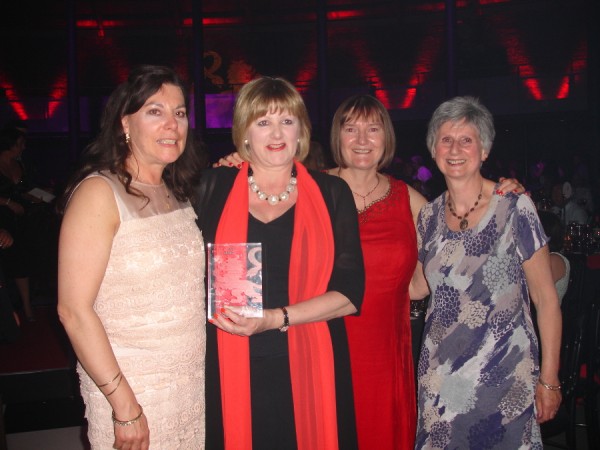
The Missenden Abbey Contingent: Jill Booker (Floristry Tutor) Jill Harden (Medal Winner, Floristry and Lion Award) Jane Robinson (Medal Winner, Stitched Textiles), and Janet Edmonds (Embroidery Tutor)
What a night! City and Guilds did us proud, with a great celebration of all the awards. Congratulations to Jill Harden, who also picked up a Lion Award for her Floristry course. Well done Jill and Jill!
Here I am on my first (and probably only) red-carpet photo-session! With any luck the official ones will be slightly better…(later comment – no, they weren’t!)
For me, one of the awards that particularly stood out was for Samith Rajapaksha, who travelled all the way from Sri Lanka to collect his award for International Learner of the Year. To do his course and get to his work-place, he had to walk two hours from his village every day. I liked his statement that ‘no dream is too big and no dreamer is too small’. I was also pleased to see an award for Ian Reynolds, Community Supporter of the Year, for his work supporting carers, ‘the forgotten people’.
It was a great evening; drinks, acrobats, eats, entertainments, speeches, awards, posh frocks, more drinks, and lots of socialising. We had some great conversations with so many interesting people, from different subjects, different age-groups and different social backgrounds. The one thing in common was a sense of energy, enthusiasm and excitement. It was great talking to some of the people in their twenties who had won awards – it was clearly a life-changing event. You could see the passion and energy that went into it all. There were a few funny conversations, such as chatting to the felt-making medal-winner while our other-halves compared notes on the silk ties made by their respective partners. Here’s DH, sporting his.
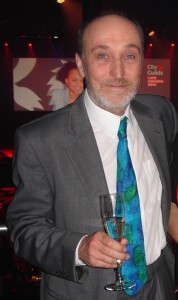
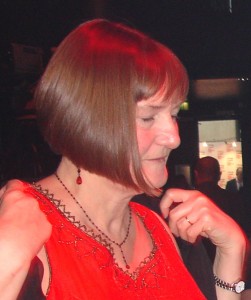 A rather strange photo on the right here, but it does record the extremely rare event of a good-hair-day, so here it is for posterity!
A rather strange photo on the right here, but it does record the extremely rare event of a good-hair-day, so here it is for posterity!
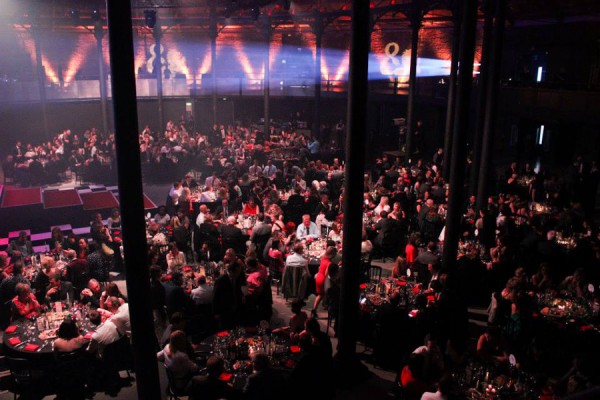
Indian doodles and dress-making
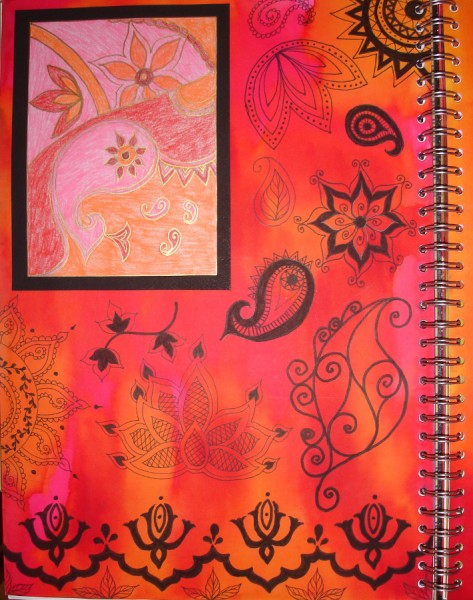
I love the vibrant, highly saturated colours that are so special to Rajasthan. Here are some bits of art-work and a couple of stitch-samples from the Diploma course, based on Indian motifs. Designing and making the dress that I mentioned in my previous post seemed like a great opportunity to to explore these Indian themes further.
I had reached the doom-and-disaster phase of the project (does everyone get that I wonder???) when luckily my fellow Diploma students and I had one of our get-togethers. Settled in the sun in Elaine’s garden, I had the full focus of three ‘helpers’ to re-pin, adapt, cut and re-tweak the prototype. There was also great encouragement not to abandon the project. I think we ended up with something that looks less like a hospital gown and more like a dress!
On that basis I unpicked the prototype and made a new pattern, and dyed the viscose silk velvet to make the finished piece. Here’s the dyed fabric. I love viscose silk velvet because of the way it drapes, and catches the light as it moves. It soaks up dye in great thirsty gulps, which means you can achieve a really highly saturated colour. 3 metres of heavy fabric would be difficult to dye evenly by hand, so I did it in the washing-machine using Dylon machine-dye. Strangely, Dylon don’t seem to have a deep mid-red, so I used a tub of Orange and a tub of pinky-red. Luckily my theory worked, and it came out a deep mid-red colour. Designs for the neck and hem are based on the doodles below, which are a kind of embellished Taj-Mahal motif. Underneath that are some stitch samples for the dress (Janet trained us well!) Now the dress is half-made-up and I’ve started the machine-stitching on soluble fabric round the neck. I hope it works out OK. Eek! Watch this space!
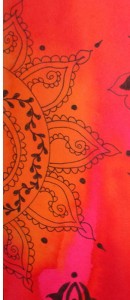
Indian doodles – detail
City and Guilds Medal Award Ceremony
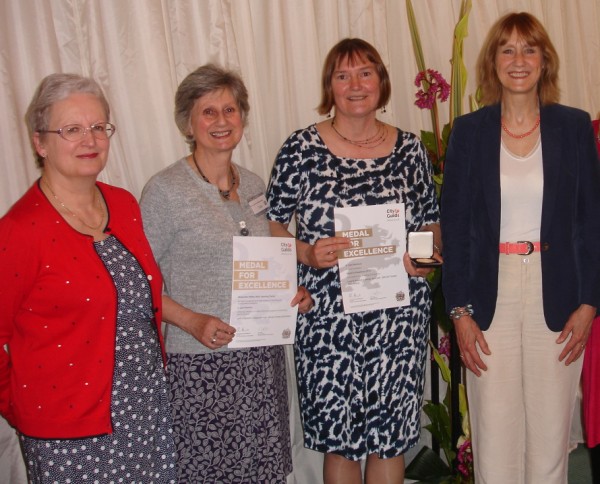
Medal Presentation. Left to right: Margaret Walker, Chief Verifier for Creative Studies at City and Guilds; Janet Edmonds, Embroidery Tutor; Me; Beth French, Adult Learning Service Manager for Bucks CC.
What a big day on Saturday! Missenden Abbey hosted a lovely event for the presentation of the City and Guilds Gold Award Medal for Excellence for Stitched Textiles and for Floristry. There were a hundred or so people in the audience, including current City and Guilds students, my fellow Diploma students, Missenden Abbey staff, and DH for moral support. Thanks to Alison Pearce at the Abbey for organising a lovely event. It was all quite nerve-racking for someone who doesn’t like to be the centre of attention, but I really appreciated that the Abbey made it a special occasion. Despite my nerves it was lovely to be made a fuss of. The ceremony was for two of us – Jill Harden won a Medal for Excellence for her Floristry course. Here’s a photo of all of us.
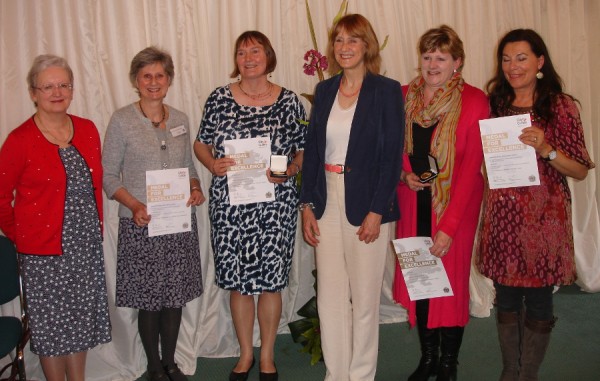
Margaret Walker, Janet Edmonds, Me, Beth French, Jill Harden, Floristry Award Winner, and Jill Booker, Floristry Tutor.
It felt very unreal to be receiving this award, because of my real diffidence, many years ago now, about signing on for the first part of the course (now the Certificate, then ‘Part One’.) I remember seeing the end of course show at Northbrook College and feeling inspired to try it but also feeling quite intimidated because I didn’t see how I could possibly reach a sufficient standard to do the first course, let alone the second one. Luckily the tutor, Sue Munday, made me laugh about this apprehension and so she was able to introduce me to the delights of design, colour, stitch and particularly machine-embroidery. It was many years later that I signed up for the Diploma Course with Janet Edmonds, and continued the creative journey. Janet has been an inspiring and encouraging teacher, who has opened door after door into new worlds. Her own work is amazing, and we have all learned so much.
I was really pleased that my fellow-students were able to come to the presentation. The support of the group has got us all through many ‘life events’ during the course, as ‘life’ has taken it’s twists and turns over the three years. It has been a pleasure to work alongside such positive and enthusiastic people, who are now firm friends. Here we are, together with Janet Edmonds.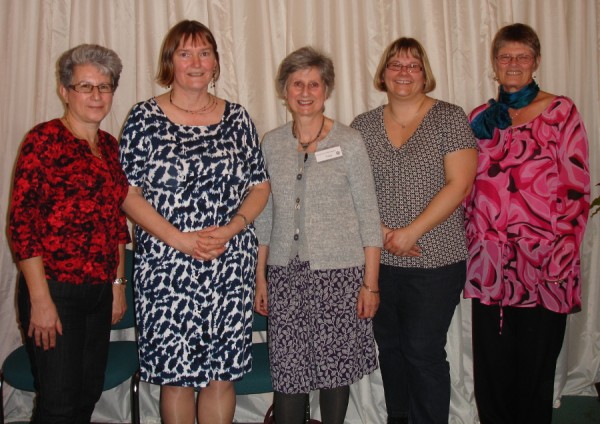
Here’s Janet receiving her thank-you present from us, some time ago now, at the end of the course. It’s a sewing-roll, designed by Cheryl and stitched to her instructions by the four of us.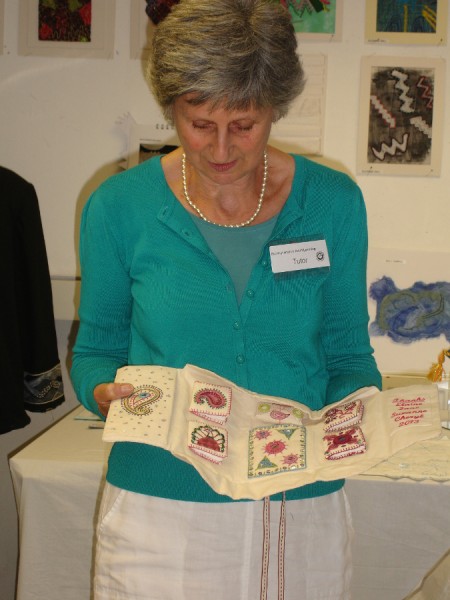
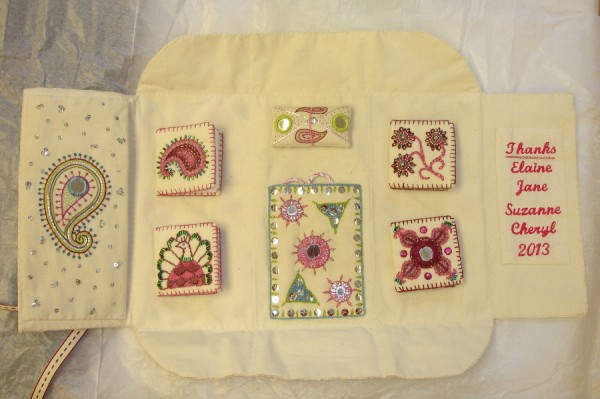
‘…a heaven in a wild flower’
To see a world in a grain of sand,
And a heaven in a wild flower,
Hold infinity in the palm of your hand,
And eternity in an hour. (William Blake)
People ask me why I’m setting up a website and blog. Sometimes I burble something about creativity and joy, but I often trail off in favour of the ‘sensible’ reasons, such as ‘I hope to develop my textile art more professionally’ or ‘I plan to offer work for sale’. Occasionally I talk to someone who ‘gets it’ straight away, which encourages me to carry on with my rather vague and half-hatched ideas (thank you Holger in particular, for insight and encouragement just at the right point).
Anyone with a passionate special interest may know the intense pleasure of being totally, ridiculously absorbed. I find that a strange thing happens when I’m involved in art or stitch. The annoying, insistent logical left brain gets blocked, and the more diffident, easily intimidated creative right brain finally has space. Irritating things that get in the way are quite simply shut out (clocks, timetables, sharp or jagged noises, and all the insistent things that bleep, ping, flash, ring and insist on our attention right now). Time quite literally seems to stand still; but at the same time, in a way that I don’t understand, an hour can expand to become a day. Whoever decided that the day could only have only 24 hours in it is tricked into allowing some secret extra hours to slip in. You really can go to Narnia, have adventures for months, and get back in less than a minute. There is time to really look. Eventually something from the so-called ‘real’ world forces itself back in, and the volume of the ticks and tocks gets turned up again. But something wonderful happens when you share this total absorption with other people. The two worlds become less separated, and it is easier to cross from one to the other. I’m grateful to my fellow students on the City and Guilds Stitched Textiles course at Missenden Abbey for their shared obsession and absorption in minute details of important things, like colours, textures and shapes. I appreciate things that other people share on their websites or blogs (images, ideas, original work, thoughts and observations). So it’s time to add my own offerings.
Kevin, the magician who set this website up with me last week is away travelling, so I’m like a brand new driver out on the motorway with no instructor. I promised to try not to break the website while he’s away. I did manage to delete the whole Gallery instead of one image, but thankfully I found a way to reinstate it. Please bear with me if strange things happen. Anyway, I’m glad you’ve found my blog, and I’d love to know who you are and how you got here.
Goldwork embroidery: 3D floating fossil rock
This embroidered floating fossil rock was a Goldwork piece for the City and Guilds Diploma in Stitched Textiles (Embroidery). It uses traditional metal thread techniques. Silk and viscose velvet was dyed with Procion dye, and the ‘veins’ in the rock were machine-stitched with Madeira FS20 thread in black and gold. The goldwork fossils are stitched with traditional metal thread techniques (leather kid, jap, purls and pearl purl) and the fabric is then scrunched and tweaked into the 3D rock. It floats on electro-magnets, using ‘Levitron Fascinations EZ float’ technology.
I hope you enjoy it.










